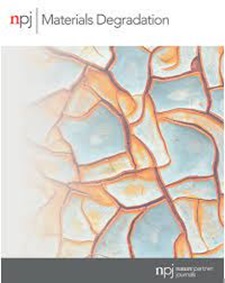海洋应用中添加制造铝合金的抗腐蚀性能
IF 7.6
2区 材料科学
Q1 MATERIALS SCIENCE, MULTIDISCIPLINARY
引用次数: 0
摘要
增材制造为使用铝合金设计轻质结构提供了新的可能性。研究了两种铝合金的微观结构及其在氯化钠和天然海水环境中的耐腐蚀性。在打印和热处理条件下,新设计的 Al-Mn-Cr-Zr 基合金在这两种环境中都表现出比 AlSi10Mg 合金更高的耐腐蚀性。在沃尔塔电位差最大的合金中,腐蚀是沿着析出物在铝基体中开始的。与 AlSi10Mg 合金相比,新型铝合金更粗糙的微观结构和沉淀成分导致形成了一层抗腐蚀的被动膜,从而扩大了 Al-Mn-Cr-Zr 合金的被动区域。热处理的影响体现在微观结构上,因为在熔池边界之间发现了更多的析出物,这影响了腐蚀的发生,并略微影响了抗点蚀性。总之,这项研究表明,新设计的增材制造铝合金具有适合海洋环境应用的耐腐蚀性。本文章由计算机程序翻译,如有差异,请以英文原文为准。


Corrosion resistance of additively manufactured aluminium alloys for marine applications
Additive manufacturing opens new possibilities for designing light-weight structures using aluminium alloys. The microstructure of two Al alloys and their corrosion resistance in NaCl and natural seawater environments were investigated. The newly designed Al-Mn-Cr-Zr based alloy showed a higher corrosion resistance than reference AlSi10Mg alloy in both environments in as printed and heat-treated conditions. The corrosion initiated in the Al matrix along the precipitates in the alloys where the Volta potential difference was found the highest. The coarser microstructure and precipitate composition of the new Al-alloy led to the formation of a resistant passive film which extended the passivity region of the Al-Mn-Cr-Zr alloy compared to the AlSi10Mg alloy. The effect of heat treatment could be seen in the microstructure as more precipitates were found in between the melt pool boundaries, which affected the corrosion initiation and slightly the pitting resistance. Overall, this study shows that a newly designed Al-alloy for additive manufacturing has a suitable corrosion resistance for applications in marine environments.
求助全文
通过发布文献求助,成功后即可免费获取论文全文。
去求助
来源期刊

npj Materials Degradation
MATERIALS SCIENCE, MULTIDISCIPLINARY-
CiteScore
7.80
自引率
7.80%
发文量
86
审稿时长
6 weeks
期刊介绍:
npj Materials Degradation considers basic and applied research that explores all aspects of the degradation of metallic and non-metallic materials. The journal broadly defines ‘materials degradation’ as a reduction in the ability of a material to perform its task in-service as a result of environmental exposure.
The journal covers a broad range of topics including but not limited to:
-Degradation of metals, glasses, minerals, polymers, ceramics, cements and composites in natural and engineered environments, as a result of various stimuli
-Computational and experimental studies of degradation mechanisms and kinetics
-Characterization of degradation by traditional and emerging techniques
-New approaches and technologies for enhancing resistance to degradation
-Inspection and monitoring techniques for materials in-service, such as sensing technologies
 求助内容:
求助内容: 应助结果提醒方式:
应助结果提醒方式:


